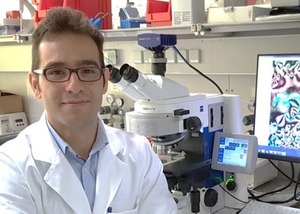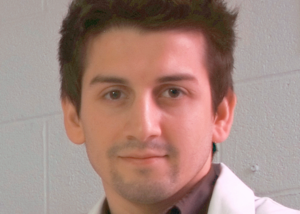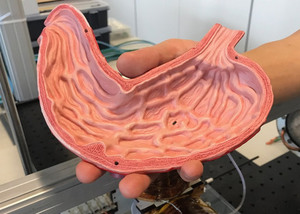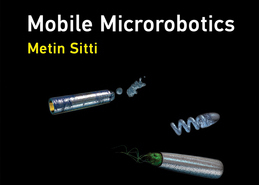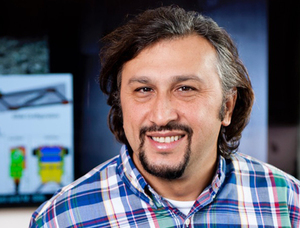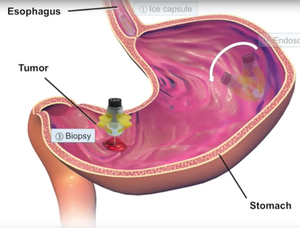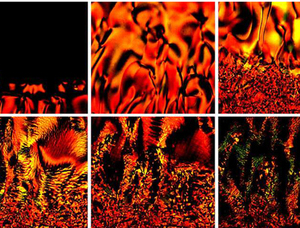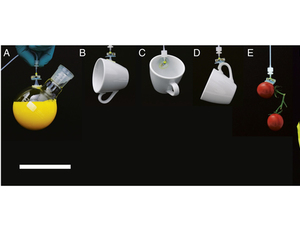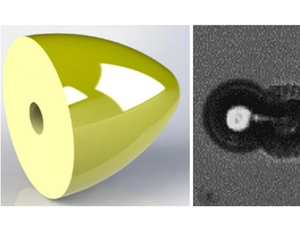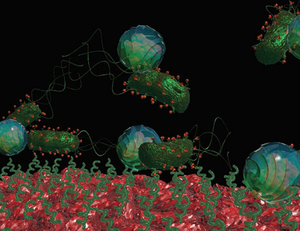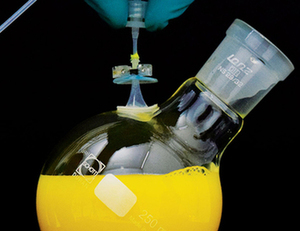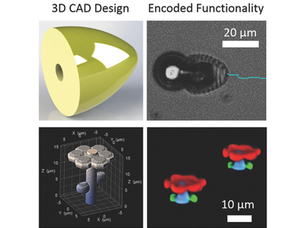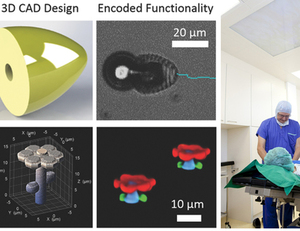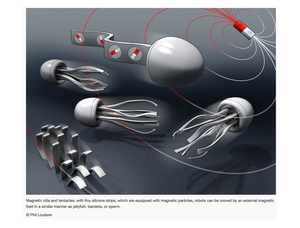News
Physical Intelligence
News
28-06-2018
A multifunctional, multiscale, reconfigurable surface
Composite surface has features that can move microparticles, mix droplets, repel biofilms and more.
Wendong Wang
Physical Intelligence
News
22-06-2018
Smart Materials Engineer choses MPI-IS for his NSERC Postdoctoral Fellowship
Dr. Hamed Shahsavan receives a prestigious Postdoctoral Fellowship from the Natural Sciences and Engineering Research Council (NSERC) of Canada, the country´s federal funding agency for university-based research and student training in natural sciences and engineering. The smart materials engineer choses the Max Planck Institute for Intelligent Systems for his research stay because of the state-of-the-art facilities provided there.
Hamed Shahsavan
Metin Sitti
Physical Intelligence
News
17-05-2018
Research prize by the Alexander von Humboldt Foundation for Prof. Dr. David H. Gracias
Sabbatical of the recipient will take place in the Physical Intelligence Department at the Max Planck Institute for Intelligent Systems in Stuttgart.
Physical Intelligence
News
26-04-2018
Multifunctional bacterial microswimmer able to deliver cargo and destroy itself
The untethered biohybrid microswimmer is able to transport and deliver cargo encapsulated into a guidable red blood cell, while an attached bacterium, one of the most efficient swimmers in nature, acts as a propeller to move it forward. Once it has reached its destination and delivered its cargo, the scientists can destroy the microswimmer using infrared light.
Yunus Alapan
Oncay Yasa
Metin Sitti
Physical Intelligence
News
12-03-2018
Yunus Alapan to attend the Lindau Nobel Laureate Meetings
The postdoctoral researcher from the Physical Intelligence Department at the Max-Planck-Institute for Intelligent Systems in Stuttgart is one of the 600 young scientists who is given the opportunity for a week of scientific exchange with the greatest minds in medical research.
Yunus Alapan
Metin Sitti
Physical Intelligence
News
22-02-2018
Four Postdoc researchers join the Physical Intelligence Department thanks to a Humboldt Postdoctoral Research Fellowship
Each year, the Alexander von Humboldt Foundation grants approximately 500 fellowships to Postdoctoral Researchers of all nationalities and disciplines from abroad to continue their research in Germany. Four AvH fellows join the Max Planck Institute for Intelligent Systems in Stuttgart.
Zoey Davidson
Ville Liimatainen
Utku Culha
Metin Sitti
Abdon Pena-Francesch
Physical Intelligence
News
25-01-2018
Millirobot with a talent for versatility of movement
A magnetic drive allows a tiny untethered vehicle to walk, crawl, jump and swim through a complex environment
Tiny robots need not fear obstacle courses in the future: Scientists from the Max Planck Institute for Intelligent Systems in Stuttgart have developed a minuscule, flexible robot that can master a variety of forms of movement. Its magnetic drive allows it to walk, crawl and roll through difficult terrain. Moreover, it can transport small loads and swim on and in liquids. In future, tiny robots moving in this way could transport medication specifically to where it is needed.
Wenqi Hu
Guo Zhan Lum
Massimo Mastrangeli
Metin Sitti
Physical Intelligence
News
24-01-2018
Nature-inspired soft millirobot makes its way through enclosed spaces
Scientists at the Max Planck Institute for Intelligent Systems invented a magnetically controlled soft robot only four millimeters in size, that can walk, crawl or roll through uneven terrain, carry cargo, climb onto the water surface, and even swim in it. The inspiration comes from soft-bodied beetle larvae and caterpillars, and even jellyfishes posed as biological models. One day, this small-scale robot may enable targeted drug delivery or minimally invasive surgery, the researchers hope. Its multiple locomotion capability in complex environments is so unique that science journal Nature will publish the researchers´ findings in its February edition.
Metin Sitti
Guo Zhan Lum
Massimo Mastrangeli
Physical Intelligence
News
11-07-2017
Mobile Microrobotics
New book from Metin Sitti
Progress in micro- and nano-scale science and technology has created a demand for new microsystems for high-impact applications in healthcare, biotechnology, manufacturing, and mobile sensor networks. The new robotics field of microrobotics has emerged to extend our interactions and explorations to sub-millimeter scales. This is the first textbook on micron-scale mobile robotics, introducing the fundamentals of design, analysis, fabrication, and control, and drawing on case studies of existing approaches.
Metin Sitti
Physical Intelligence
News
19-06-2017
Robotta insan hücresi
Prof. Dr. Metin Sitti gives an interview on Milliyet.com.tr
Describing the work that will create micro robot revolution in health Prof. Dr. Metin Sitti has said that the cyborg system in which human cells are transferred to robots is in the process of animal experimentation ...
Metin Sitti
Physical Intelligence
News
14-06-2017
A Colonoscopy Robot and Other Weird Biomedical Tech From IEEE's Biggest Robotics Conference
Swallowable biopsy robot of doom
Metin Sitti
Mehmet Turan
Donghoon Son
Physical Intelligence
News
01-06-2017
Programmable self-assembly
Scientists under the lead of Metin Sitti at the Max Planck Institute for Intelligent Systems in Stuttgart have recently constructed a material system that provides dynamic self-assembly.
To be alive, biologically speaking, means to be able to breath, to eat, to drink, to grow, to age, and, perhaps, to move. Food is the energy source, and metabolism translates the stored chemical energy into biochemical energy to sustain live functions. The physical abstraction of this energy transduction by living organisms is extremely simple: it involves energy input and energy dissipation. This mechanistic view of life looks almost trivial, but to apply this type of thinking in the design of materials and material systems is non-trivial. Scientists under the lead of Metin Sitti at the Max Planck Institute for Intelligent Systems in Stuttgart have recently constructed a material system that requires continuous magnetic energy input and viscous dissipation to maintain its spatiotemporal patterns, and the term usually used to describe this type of material system in the research community is dynamic self-assembly.
Metin Sitti
Wendong Wang
Physical Intelligence
News
30-05-2017
Physicists discover why drying liquid crystal drops leave unusual 'coffee rings'
Phys.org
Penn alumnus Zoey Davidson, now a postdoc at the Max Planck Institute for Intelligent Systems in Germany, had been experimenting with Sunset Yellow, a dye that gives Doritos and orange soft drinks their bright colors, when he accidentally spilled some of the material.
Metin Sitti
Zoey Davidson
Physical Intelligence
News
26-05-2017
Gecko-inspired multipurpose gripper
An elastic membrane covered with tiny fibres paired with a pressure differential enables a new soft gripper system with a high adhesion performance even on curved surfaces
Robots generally need a gripper that adapts to three-dimensional surfaces. Such a gripper needs to be soft to adapt to a great variety of geometries, but not too soft, as it will detach easily and not be able to bear weight for very long. Researchers working with Metin Sitti at the Max Planck Institute for Intelligent Systems in Stuttgart developed a membrane equipped with microscopic fibres inspired by the fine hairs on a gecko's foot and attached it to a suction cup-like flexible body. An internal pressure differential ensures perfect conformation of the flexible gripper to a wide variety of surfaces and equally distributes the load over the entire contact interface. As a result, the researchers suppressed load induced stress concentrations at the edges, which strongly reduced the adhesion. The gripper demonstrates a 14-times higher adhesion than grippers without this load sharing mechanism.
Metin Sitti
Sukho Song
Dirk Drotlef
Physical Intelligence
News
22-05-2017
Functional Microrobots Could Harbor Bioengineering Apps
HospiMedica.com
A new study suggests that untethered micron-scale mobile robots can navigate and non-invasively perform specific tasks inside hard-to-reach body sites.
Currently being designed, fabricated, and tested at the Max Planck Institute for Intelligent Systems and Carnegie Mellon University, the first-generation microrobots will be able to deliver therapeutics and other cargo to targeted body sites, as well as to enclosed organ-on-a-chip microfluidic devices with live cells. A new two-step approach is use to provide the microrobotic devices with desirable functions. The first step uses three-dimensional (3D) laser lithography to crosslink light-responsive polymers.
Metin Sitti
Hakan Ceylan
Immihan Ceren Yasa
Physical Intelligence
News
18-05-2017
Bacteria-Driven Drug Delivery Carriers: A Paradigm Shift
Advanced Science News
Congrats to Babak, Oncay and Jiang that their paper, “Bioadhesive bacteria-driven microswimmers for targeted drug delivery in the urinary and gastrointestinal tracts”, is highlighted on their news website
Metin Sitti
Babak Mostaghaci
Oncay Yasa
Jiang Zhuang
Physical Intelligence
News
16-05-2017
3D-microrobots voor minuscule chirurgie
fpt-vimag.n
Een kleine robot die door een eenvoudige medische injectie in het menselijk lichaam wordt gebracht en daar rechtstreeks en doelgericht een niet te opereren tumor bestrijdt. Dit klinkt misschien een beetje als science fiction, maar onderzoekers werken momenteel druk aan het moderniseren van de gezondheidszorg met behulp van bio-engineering. De uitdagingen zitten vooral in het ontwerp, productieproces en de codering van de microrobots die dit moeten gaan realiseren.
Metin Sitti
Hakan Ceylan
Immihan Ceren Yasa
Physical Intelligence
News
16-05-2017
Sticky gripper can lift flasks and tomatoes
Nature.com A gecko-inspired adhesive could help robots to climb bumpy walls and grasp fragile objects.
The hairs that make geckos’ feet sticky have inspired the invention of adhesives for flat surfaces, but creating strong adhesives that can grab complex, 3D objects has proved a challenge.
Metin Sitti at the Max Planck Institute for Intelligent Systems in Stuttgart, Germany, and his colleagues spread elastic microfibres, or ‘hairs’, across a soft, stretchy membrane, allowing it to mould and stick to a surface. The team attached this to a ‘gripper’ layer. Reducing the pressure inside the gripper spreads the load evenly across the sticky membrane, strengthening the bond between it and the target object. Changing the pressure in the system increased the membrane’s ‘stickiness’ 14-fold, allowing the device to suspend a variety of hard and soft objects, from fluid-filled flasks to tomatoes.
Metin Sitti
Sukho Song
Dirk Drotlef
Physical Intelligence
News
15-05-2017
Sciencemag.org Gecko-inspired gripper could help robots climb walls
“The design of the backing is key to making these adhesives function properly for most applications, and this is a very exciting development.” The technology has several potential applications, says Metin Sitti, an author of the study and a mechanical engineer at the Max Planck Institute ...
Metin Sitti
Sukho Song
Dirk Drotlef
Physical Intelligence
News
11-05-2017
3D-Mikroroboter für minimal-invasive Chirurgie (Medizin Aspekte)
medizin-aspekte.de
Ein kleiner Roboter, der mühelos mittels Injektion in den menschlichen Körper gelangt, die gesunden Organe meidet und das Ziel – einen nicht operablen Tumor – findet und direkt behandelt… Klingt dies nicht nach Science-Fiction? Um es Wirklichkeit werden zu lassen, arbeiten immer mehr Forscher an der Vision, wesentliche Bereiche der Medizin und Biotechnologie zu revolutionieren. Das Design und die Herstellung solcher Mikroroboter, sowie auch die Ausstattung mit den entsprechenden Funktionalitäten, stellen jedoch noch große Herausforderungen dar.
Metin Sitti
Hakan Ceylan
Immihan Ceren Yasa
Physical Intelligence
News
05-05-2017
3D-Mikroroboter für minimal-invasive Chirurgie
Innovations-report.de
Wissenschaftler am Max-Planck-Institut für Intelligente Systeme in Stuttgart haben einen Herstellungsprozess für Mikroroboter entwickelt. Diese könnten zukünftig miminal-invasiv schwer zugängliche Körperteile wie das Gehirn, das Rückenmark oder das Auge erreichen
Ein kleiner Roboter, der mühelos mittels Injektion in den menschlichen Körper gelangt, die gesunden Organe meidet und das Ziel – einen nicht operablen Tumor – findet und direkt behandelt… Klingt dies nicht nach Science-Fiction?
Metin Sitti
Hakan Ceylan
Immihan Ceren Yasa
Physical Intelligence
News
03-05-2017
3D-Mikroroboter für minimal-invasive Chirurgie
E-health-com.de
Wissenschaftler am Max-Planck-Institut für Intelligente Systeme in Stuttgart haben einen Herstellungsprozess für Mikroroboter entwickelt. Diese könnten zukünftig miminal-invasiv schwer zugängliche Körperteile wie das Gehirn, das Rückenmark oder das Auge erreiche.
Metin Sitti
Hakan Ceylan
Immihan Ceren Yasa
Physical Intelligence
News
03-05-2017
3D-Mikroroboter für minimal-invasive Chirurgie (NeoDoc)
neodoc.de
Wissenschaftler am Max-Planck-Institut für Intelligente Systeme in Stuttgart haben einen Herstellungsprozess für Mikroroboter entwickelt. Diese könnten zukünftig miminal-invasiv schwer zugängliche Körperteile wie das Gehirn, das Rückenmark oder das Auge erreichen
Metin Sitti
Hakan Ceylan
Immihan Ceren Yasa
Physical Intelligence
News
03-05-2017
Kleinstroboter für größte OP-Erfolge
unternehmen-heute.de
Die moderne Medizin macht oft große Fortschritte im kleinen Maßstab. Am Max-Planck-Institut für Intelligente Systeme in Stuttgart wird an Mikrorobotern geforscht, die Körperteile wie das Gehirn, das Rückenmark oder das Auge erreichen können.
Metin Sitti
Hakan Ceylan
Immihan Ceren Yasa
Physical Intelligence
News
22-02-2017
3D-microdevice for minimally invasive surgeries
Scientists take challenge of developing functional microdevices for direct access to the brain, spinal cord, eye and other delicate parts of human body
A tiny robot that gets into the human body through the simple medical injection and, passing healthy organs, finds and treats directly the goal – a non-operable tumor… Doesn’t it sound at least like science-fiction? To make it real, a growing number of researchers are now working towards this direction with the prospect of transforming many aspects of healthcare and bioengineering in the nearest future. What makes it not so easy are unique challenges pertaining to design, fabrication and encoding functionality in producing functional microdevices.
Metin Sitti
Hakan Ceylan
Immihan Ceren Yasa
Physical Intelligence
News
26-09-2016
Shape-programmable miniscule robots
Soft materials that can use magnetic fields to generate desired time-varying shapes could provide an engine for microswimmers
One day, microrobots may be able to swim through the human body like sperm or paramecia to carry out medical functions in specific locations. Researchers from the Max Planck Institute for Intelligent Systems in Stuttgart have developed functional elastomers, which can be activated by magnetic fields to imitate the swimming gaits of natural flagella, cilia and jellyfish. Using a specially developed computer algorithm, the researchers can now automatically generate the optimal magnetic conditions for each gait for the first time. According to the Stuttgart-based scientists, other applications for this shape-programming technology include numerous other micro-scale engineering applications, in which chemical and physical processes are implemented on a miniscule scale.
Metin Sitti
Guo Zhan Lum
Physical Intelligence
News
18-05-2016
Switch and stick
The chemical element gallium could be used as a new reversible adhesive that allows its adhesive effect to be switched on and off with ease
Some adhesives may soon have a metallic sheen and be particularly easy to unstick. Researchers at the Max Planck Institute for Intelligent Systems in Stuttgart are suggesting gallium as just such a reversible adhesive. By inducing slight changes in temperature, they can control whether a layer of gallium sticks or not. This is based on the fact that gallium transitions from a solid state to a liquid state at around 30 degrees Celsius. A reversible adhesive of this kind could have applications everywhere that temporary adhesion is required, such as industrial pick-and-place processes, transfer printing, temporary wafer bonding, or for moving sensitive biological samples such as tissues and organs. Switchable adhesion could also be suitable for use on the feet of climbing robots.
Metin Sitti
Zhou Ye
Guo Zhan Lum
Sukho Song
Physical Intelligence
News
13-03-2016
Gentle strength for robots
A soft actuator using electrically controllable membranes could pave the way for machines that are no danger to humans
In interacting with humans, robots must first and foremost be safe. If a household robot, for example, encounters a human, it should not continue its movements regardless, but rather give way in case of doubt. Researchers at the Max Planck Institute for Intelligent Systems in Stuttgart are now presenting a motion system - a so-called elastic actuator - that is compliant and can be integrated in robots thanks to its space-saving design. The actuator works with hyperelastic membranes that surround air-filled chambers. The volume of the chambers can be controlled by means of an electric field at the membrane. To date, elastic actuators that exert a force by stretching air-filled chambers have always required connection to pumps and compressors to work. A soft actuator such as the one developed by the Stuttgart-based team means that such bulky payloads or tethers may now be superfluous.
Metin Sitti
Lindsey Hines
Kirstin Petersen
Physical Intelligence
News
04-09-2015
New adhesive mimics gecko biology
thetartan.org
It’s a typical afternoon at the zoo, and you find yourself looking at the exhibits of reptiles and amphibians in miniature imitations of wild and exotic habitats. At one of the displays you notice a gecko crawling on a window with superhero ease.
Metin Sitti

